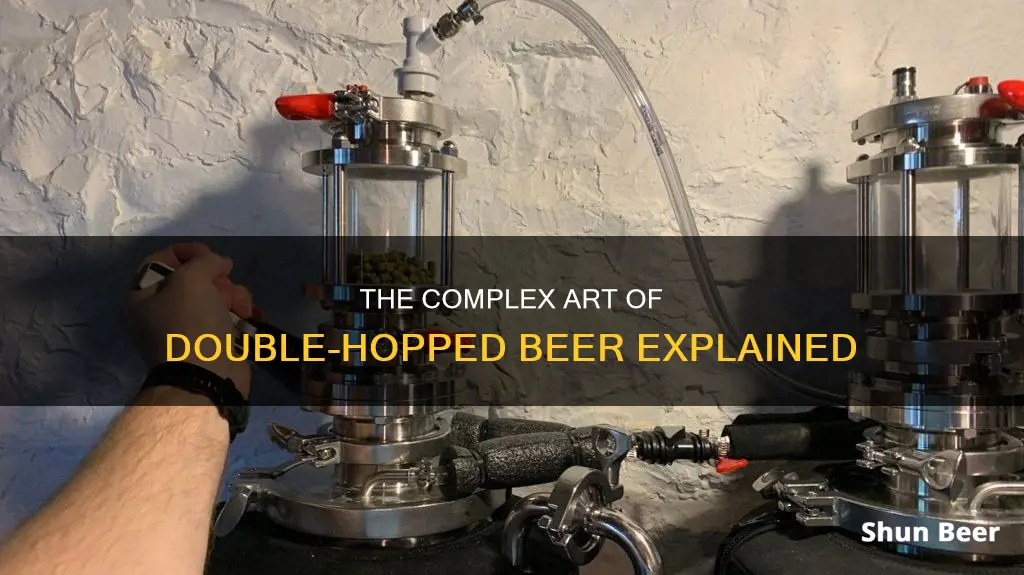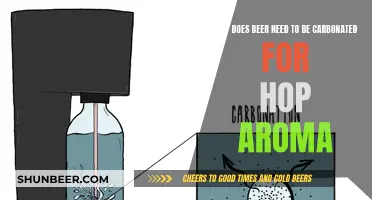
Beer lovers may be familiar with the acronym DDH on beer labels and menus, which stands for double dry-hopped. This term is often used for IPAs, and specifically New England-style IPAs, which have become increasingly popular. While the process of double dry-hopping is not clearly defined, it generally involves adding hops to the beer after the liquid has cooled and is fermenting, resulting in brighter, more vibrant hop flavours and robust aromas without the bitterness that comes from boiling hops. The doubling aspect of double dry-hopping can be interpreted in different ways and may refer to either using twice as many hops or dry hopping twice during the brewing process.
| Characteristics | Values |
|---|---|
| What is DDH? | Double Dry Hopped |
| What does DDH stand for? | Double Dry Hopped |
| What type of beer is DDH used for? | India Pale Ale (IPA) |
| When are hops added to DDH beer? | After the liquid has cooled, during the primary or secondary fermentation phase |
| What does dry-hopping do? | Infuses brighter, more vibrant hop flavours and robust aromas without the bitterness |
| What does "doubling" mean? | Dry hopping twice or using twice as many hops |
| What are the characteristics of double-dry hopped beers? | Tropical fruit notes, such as peach, pineapple, and mango |
What You'll Learn

Double dry-hopped beers are India Pale Ales (IPAs)
Dry hopping infuses brighter, more vibrant hop flavours and robust aromas without the bitterness that comes with traditional brewing methods. The term "double dry-hopped" is often abbreviated as "DDH" on beer labels and taproom chalkboards.
The specific meaning of "double dry-hopped" can vary among brewers. For some, it may refer to dry hopping the beer twice, while for others, it may mean using twice the amount of hops during a single dry-hopping process. This ambiguity has led to some confusion among beer enthusiasts and has sparked discussions about whether the term is more of a marketing strategy than a distinct beer style.
However, the process of double dry hopping has become particularly associated with New England-style IPAs, also known as Hazy or Juicy IPAs. These beers are known for their big, vibrant hop aromas and flavours, with notes of tropical fruits such as peach, pineapple, and mango. The rise in popularity of these New England-style IPAs has driven brewers to experiment with different hopping techniques to create unique and distinctive beers.
Whether it's through multiple dry-hopping sessions or a larger quantity of hops, double dry-hopped beers offer a more intense hoppy experience that has gained a dedicated following among craft beer enthusiasts.
Hops in Beer: Healthy or Harmful?
You may want to see also

Hops are added to DDH beers after fermentation begins
Hops are traditionally added to beer during the boil. This extracts the oils from the cones or processed pellets, creating flavours and aromas, as well as adding bitterness to the finished product.
However, in double dry-hopped (DDH) beers, hops are added after fermentation begins. This is known as dry hopping, and it is done to add more aroma and flavour without increasing bitterness.
The process of dry hopping involves adding hops to a lager or ale after the liquid has cooled, while it is in its primary or secondary fermentation phase. This can be done during or right after primary fermentation, or a few days before bottling or kegging.
The "doubling" in DDH beers can be achieved by either dry hopping twice or by using twice the amount of hops. This means that DDH beers will have either been dry-hopped twice or will have double the amount of hops added to them after fermentation begins.
Mastering Beer Smith 3: Displaying Multiple Dry Hops
You may want to see also

DDH beers have a vibrant, fruity flavour
Double dry-hopped (DDH) beers are known for their vibrant, fruity flavour. The process of dry hopping involves adding hops to a beer after boiling, during the primary or secondary fermentation stage. This technique is used to infuse brighter, more vibrant hop flavours and robust aromas.
The term DDH is often used to describe India Pale Ales (IPAs), which are known for their signature bitterness and hoppiness. DDH IPAs take this a step further by adding about twice as many hops as a standard single-hopped beer. This results in a beer that is even more hoppy and flavourful, with a stronger aroma.
The process of dry hopping allows brewers to add more hop aroma and flavour to the beer without increasing bitterness. This has become very popular in modern craft beer, as consumers seek out beers with big hop flavours that are not overly bitter.
The specific hops used in DDH beers can vary, but they often include varieties such as Citra, Mosaic, and Amarillo, which are known for their bright, fruity aromas and flavours. For example, the DDH Pseudo Sue by Toppling Goliath Brewing Co. showcases the Citra hop, resulting in a beer with aromas of citrus and mango.
The addition of these hops during the fermentation process enhances the fruity and citrusy notes in DDH beers. This can include flavours such as grapefruit, lemon, nectarine, and melon, as found in the Hazetronics DDH DIPA by Cherry Street Brewing. Thus, the use of dry hopping and the specific hops chosen contribute to the vibrant, fruity flavour profile of DDH beers.
Wet Hopped Beer: Fresh, Fragrant, and Flavorful
You may want to see also

The term DDH is open to interpretation
The term "DDH" is more complicated than it looks. While it stands for "Double Dry Hopped", the "doubling" part is open to interpretation. The process can differ for every brewer.
The term can mean either dry hopping twice or hopping with twice as many hops. This raises a valid question: if it is twice the amount, then what should the original amount be? If there isn't a set amount of hops to reference, it is hard to say what is double. And even if the process is repeated, the same question can be asked about the total quantity used.
There is no consensus about the exact definition of the DDH process. It could be that the term has transcended its literal definition, taking on a meaning and beer style all its own. The first "D" in "DDH" stands for "double", but if there is no single version of a beer to begin with, it can be argued that it is impossible to make a double version.
Ultimately, there is no specified amount, and each brewery double dry-hops differently.
Hop Butcher's Lactose: A Universal Addition?
You may want to see also

DDH beers are often New England IPAs
Double dry-hopped (DDH) beers are increasingly popular with the New England-style India Pale Ale (NEIPA). This style of beer relies on huge hop aromas and flavours, with very little bitterness, which is achieved through the dry-hopping process.
The dry-hopping process involves adding hops to a beer after boiling, or on the "cold side" of brewing. This is usually during primary or secondary fermentation. This process imparts aromas without leaving behind bitterness.
The term "double dry-hopped" can be interpreted in two ways. Firstly, it could mean dry hopping twice, or secondly, using twice as many hops. However, there is no clear consensus on what the term means, and different breweries interpret it in different ways.
The rise of New England-style IPAs led to a push for big, vibrant hop aromas without excessive bitterness. Brewers began to say their beers were "double dry hopped", which meant using comparatively smaller amounts of hops on the hot side of the brewing process and primarily dosing beers after fermentation.
Dry hopping, no matter the rate or volume, has become the "heart and soul" of New England-style IPAs, according to Jean-Claude Tetreault, co-founder and brewer at Trillium Brewing Co. in Massachusetts. "It's what makes these beers stand out in a crowd", he says.
Grapefruit Beer: Hops-Infused Refreshment or Not?
You may want to see also
Frequently asked questions
DDH stands for Double Dry Hopped.
Double dry hopping is a process where hops are added to the beer twice during the fermentation process, or added in twice the quantity during a single stage of the process.
Double dry hopping infuses brighter, more vibrant hop flavours and robust aromas without adding bitterness.
Double dry hopping is most commonly used in IPAs, particularly New England-style IPAs, but the process is also used in other craft beers.







